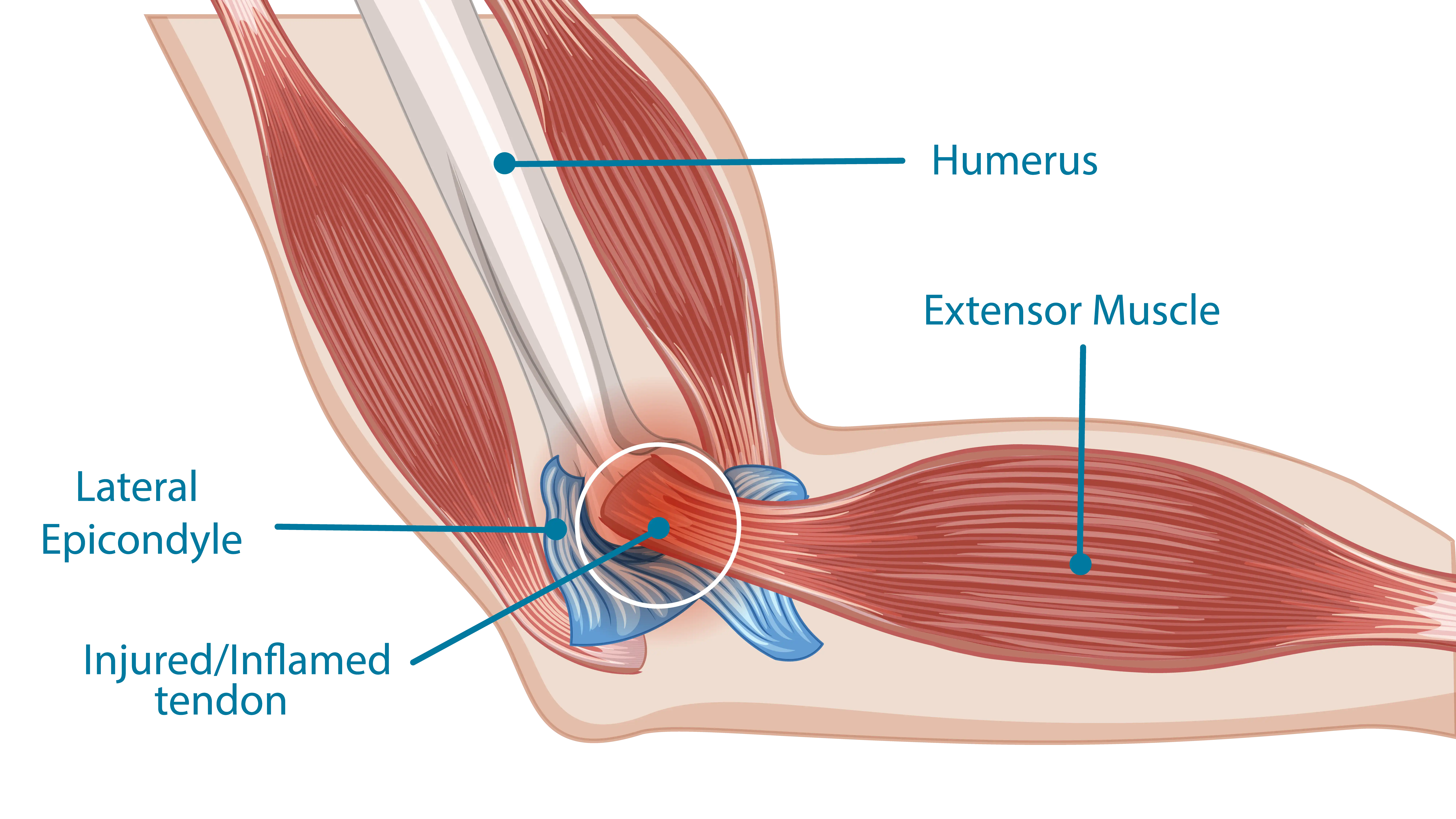Elbow pain when bending can disrupt daily life. Common causes include tennis elbow, golfer’s elbow, cubital tunnel syndrome, and bursitis. In this post, we’ll explore these common causes, along with diagnosis and treatment strategies.
Key Takeaways
- Elbow pain when bending may stem from conditions such as tennis elbow, golfer’s elbow, cubital tunnel syndrome, and bursitis, each requiring specific management strategies.
- Accurate diagnosis, generally involving physical examination and imaging tests, is important for tailoring effective treatment plans.
- Preventative measures, including ergonomic adjustments, regular breaks, and protective gear, can help maintain elbow health and reduce the risk of injury.
Understanding Elbow Pain When Bending
Recognizing the type of elbow pain and its location helps in understanding the underlying condition. Tennis elbow, golfer’s elbow, cubital tunnel syndrome, and bursitis present distinct symptoms and may require tailored approaches for effective management. In the following subsections, we’ll take a closer look at each of these common conditions.
Tennis Elbow (Lateral Epicondylitis)
Tennis elbow, also known as lateral epicondylitis, is characterized by pain on the outer side of the elbow. Despite its name, anyone can be affected by tennis elbow, not just tennis players. This condition is often caused by repetitive actions involving the wrist and hand, such as gripping or lifting objects, which can lead to changes in the tendon.

Common symptoms include pain that worsens with activities, like turning a doorknob, opening a jar, or bending the arm. Grip strength may also be affected. Treatment strategies include rest, activity modifications, medications, physical therapy, and, in rare cases, surgery.
Golfer’s Elbow (Medial Epicondylitis)
Golfer’s elbow, or medial epicondylitis, affects the inner tendon of the elbow, often causing pain that radiates down the forearm muscles. This condition is typically triggered by repetitive wrist flexion or gripping activities. Symptoms may include numbness or tingling, stiffness, reduced grip strength, and pain when bending the elbow or moving the wrist.
Identifying activities that contribute to golfer’s elbow and taking preventive measures can help manage pain. Treatments include rest, ice, medications, braces, and physical therapy. For severe or persistent cases, surgery may be recommended.
Cubital Tunnel Syndrome
Cubital tunnel syndrome results from pressure on the ulnar nerve. This condition can be caused by a variety of factors, including bands of tissue that place pressure on and compress the nerve, bone spurs, and arthritis.
Pain is often felt when bending the elbow, as it can compress the nerve and exacerbate symptoms. This pressure may also lead to symptoms like numbness and tingling in the ring and little fingers. In more advanced cases, the muscles in the forearm and hand that are important for grip and dexterity can be affected.
Managing cubital tunnel syndrome typically involves identifying its triggers and adopting strategies to reduce pressure. In some cases, surgical procedures to relieve nerve pressure may be considered.
Diagnosing the Cause of Elbow Pain
An accurate diagnosis is key to an appropriate treatment plan. A thorough patient history, along with a physical examination and imaging tests, can help identify the specific cause.
In the physical exam, your doctor may assess the range of motion, tenderness, and strength of the elbow to identify the source of the pain. Specific tests can help diagnose particular conditions affecting the elbow.
X-rays, magnetic resonance imaging (MRI), and ultrasound are commonly used to diagnose elbow issues. X-rays are typically used for detecting bony injuries. MRI is preferred for evaluating soft tissue structures.
This comprehensive method helps in determining the underlying cause, which guides the treatment strategy.
Treatments for Elbow Pain
Treatment of elbow pain depends on the underlying cause. Options include conservative approaches and, when needed, surgical intervention.
Nonsurgical Treatments
Various nonsurgical treatments may be recommended for certain elbow conditions.
The R.I.C.E. method (Rest, Ice, Compression, Elevation) is a widely recommended approach for managing acute pain and inflammation. For many conditions, rest can allow for proper healing and help prevent further irritation.
Over-the-counter pain relievers like non-steroidal anti-inflammatory drugs (NSAIDs) or topical pain relievers may help manage elbow pain by reducing inflammation and providing pain relief. Physical therapy can help alleviate elbow pain by building strength and improving flexibility. Exercises that enhance range of motion and strengthen the surrounding muscles generally contribute to better elbow health.
Another potential treatment is platelet-rich plasma (PRP) therapy, where the patient’s own platelets are injected into the site of injury. For some conditions, this may support healing around the site.
Surgical Procedures
Surgery may be indicated for severe elbow pain unresponsive to conservative treatments. Options can include tendon repair and nerve decompression procedures, potentially improving function and reducing pain. Elbow arthroscopy is a minimally invasive procedure where repair takes place through tiny incisions.
An experienced elbow specialist can evaluate the injury and help guide the most appropriate treatment plan for your specific condition.
Preventative Measures to Avoid Elbow Pain
Several preventive strategies can help reduce the risk of developing elbow pain. In the following subsections, we’ll explore some of these strategies.
Ergonomic Adjustments
Adjusting your workstation to keep your keyboard at elbow level and your desk at an appropriate height can help minimize strain on the elbow. Additionally, incorporating ergonomic tools, such as a supportive computer mouse, can reduce repetitive stress on the elbows.
Regular Breaks and Movement Modification
Taking short, frequent breaks during repetitive movements can lower the chance of developing elbow pain. Taking a break every 30 minutes helps allow the arms time to recover and prevent fatigue.
Protective Gear
Wearing supportive elbow braces or straps during high-stress activities may alleviate pressure and help prevent overuse injuries. Protective gear like elbow pads can also guard against impact during sports. A wrist brace can sometimes help alleviate pain from tennis elbow and serve as a reminder to avoid picking up heavy items or gripping forefully.
Summary
Understanding the causes, diagnosis, treatments, and preventative measures for elbow pain is important for effective management and recovery. Tennis elbow, golfer’s elbow, cubital tunnel syndrome, and bursitis are common causes of pain when bending the elbow. By adopting these strategies, many people can reduce pain, improve function, and avoid future injuries.
Frequently Asked Questions
What are the common causes of elbow pain when bending?
Elbow pain when bending is often caused by conditions such as tennis elbow, golfer’s elbow, cubital tunnel syndrome, and elbow bursitis. Identifying these issues early can help in managing and alleviating the pain.
How can I diagnose the cause of my elbow pain?
A combination of medical history, physical examination, and on occasion diagnostic tests (nerve conduction studies, X-rays, MRI, ultrasound) can help identify the condition.
What are some effective treatments for elbow pain?
Treatments for elbow pain include the R.I.C.E. method, over-the-counter pain relievers, physical therapy, PRP therapy, and, in severe cases, surgery. Seeking professional advice can help determine the best approach for your specific condition.
How can I prevent elbow pain?
To help prevent elbow pain, focus on ergonomic adjustments, take regular breaks, and consider using protective gear such as braces or elbow pads. Being proactive in these areas can reduce your risk of injury.
When should I seek medical attention for elbow pain?
Consider seeking medical attention for elbow pain if you experience persistent or severe pain that interferes with sleep or daily activity, swelling, numbness or tingling of the fingers, loss of strength or clumsiness in the hand, or limited mobility of the elbow.

